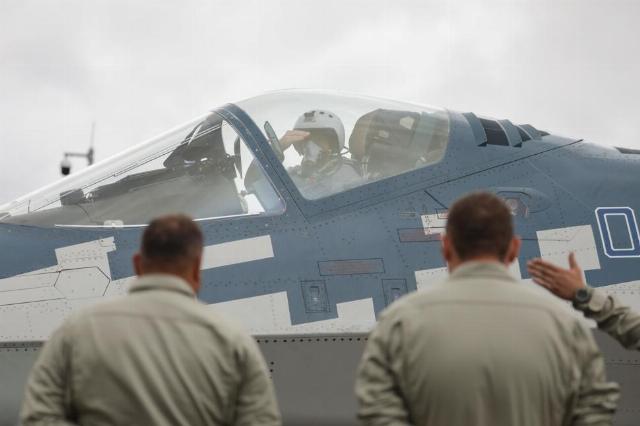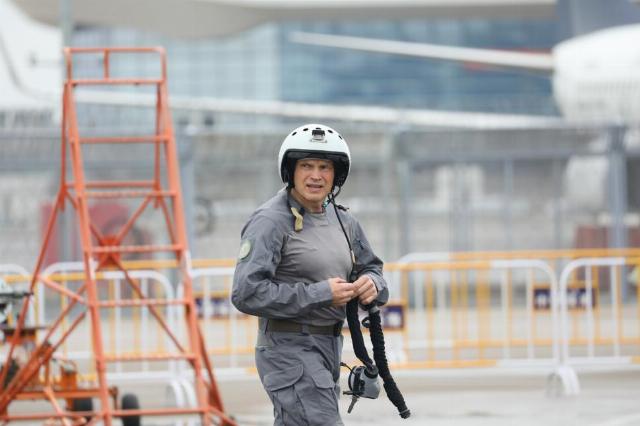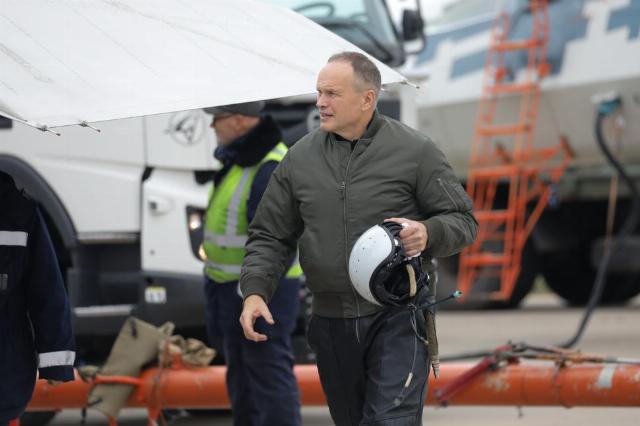The premiere of the Russian Su-57 fighter jet became a sensation at the Zhuhai Airshow in autumn 2024. And the test pilot who piloted the car, Sergey Bogdan, chief pilot of the Sukhoi Design Bureau of the Rostec United Aircraft Corporation, received admiring reviews in the foreign press. Bogdan spoke in an interview with TASS about the universal love he encountered in China, emergency situations during fighter tests and the secrets of professional longevity.
— Sergey Leonidovich, how did you become a test pilot?
— This dream appeared in childhood. First of all, my father did military service in aviation and always spoke about it with great warmth. Secondly, I lived in Voskresensk — there are landing routes over the city to Ramenskoye airfield, where experienced equipment is flying. All this was observed by the boys of our city, and what we saw did not leave our heads. So the idea came up to try it. But I've heard a lot about the need for very good health. And I also considered aviation as a backup option: if I didn't want to become a pilot, then I wanted to become an engineer or a technician. When I started thinking about what I could do for my health, I wondered: should I join the civil or military aviation?
— But they still chose the military. Why?
— As my father used to say, civil aviation has its charms: people fly all over the world and wear white shirts.… But at that time, the "birds of prey" MiG-23 and MiG-27 began to enter service. They were often shown on television. A military aerobatic team in Kubinka, flying a MiG-21, was thundering. All this really got into the soul of every boy. And this martial romance won.
He started going through all kinds of medical commissions, and submitted an application to the military enlistment office. At the school in Borisoglebsk (Borisoglebsk Aviation Training Center for flight personnel named after V.P. Chkalov, then — Borisoglebsk Higher Military Aviation School of Pilots named after V.P. Chkalov — approx. TASS) successfully passed the entrance exams and the stages of psychological selection. Then he served in a combat regiment on Su—17M2 aircraft, which allowed him to perform complex aerobatics. It was a seriously trained leadership regiment, where there were no "young people" for about four years before my recruitment. Combat training was very intensive, and combat use against ground targets was constantly practiced on aircraft at the training ground. Before transferring to the third year, when we had to fly supersonic MiG-21s, my first instructor pilot wrote in my description that it was advisable to use me for test work. I found it funny: well, what kind of test pilot am I after the second year of flying on a training aircraft? Three years have passed, and the head of air-fire and tactical training told me: "I am constantly at the training ground and I see, I think you should try to enter the test school."
— The second time you couldn't disagree?
— Then I thought about it seriously and decided to try it. He sent me to his former fellow soldier, a current test pilot at the Sukhoi Design Bureau, and gave him a letter of recommendation. It so happened that during the same period I had to continue my "replacement" service in Transbaikalia. As a result, I didn't get into the testing school until four years later, in 1991. I was a military test pilot for nine years, and I was hired as a test pilot at the Sukhoi Design Bureau in 2000.
— How would you briefly describe the main mission of a test pilot?
— To make the aircraft safe and fully meet the technical requirements. This can be achieved only by checking the aircraft in all modes, going "over the edge" of the machine's characteristics, into critical modes, and retreating to set the limits within which a combat pilot of average qualifications can fly. Check the maximum performance in terms of height, speed, angles of attack, and overload during flight, with various suspension options and alignment options. Together with the military test pilots, we bring the aircraft to the values assigned to it by the technical specifications. If, for a number of reasons, the aircraft cannot achieve these indicators — for example, in terms of handling with some kind of suspensions - then it is finalized, and then repeated tests are carried out.
— But is there still a place for romance in your profession?
— An airplane is a workplace that solves complex tasks: you prepare for each flight very seriously and carefully. You go there as if to plow, to work. Sometimes you can exhale only after a test flight, returning to the airfield. Then you can at least take a look at the beautiful sky, at the landscapes overboard. Otherwise, there is not much room for emotions.
— Do you have any favorite planes?
— This is a question from the series "do you have any favorite children". Every child has his own character, and he is very dear. There are planes that can do everything: modern Su-27, Su-35, Su-57, Su-30SM can be piloted in absolutely incredible modes, and it is safe to do so. And there are planes that can't do everything and are very strict in control, which have serious limitations on the angle of attack and overload. But they are very expensive for a test pilot, because they allow you to really test yourself and train yourself. The MiG-21 is one of the most difficult supersonic aircraft in terms of piloting. He is dear to me. The Su-24 is the same, because it requires quite strict piloting. However, so is the Su-17, which, if piloted freely enough, can lose control and fall into a tailspin.
— What planes would you really like to fly on, but still haven't been able to?
— I would really like to fly the legendary I-16, Il-2, Po-2. I also really like the "Mustang" of the Great Patriotic War. I can also mention the MiG-15 and MiG-17, which are also legendary aircraft. At one time, I underwent theoretical retraining on the MiG-25, but due to my busy schedule, I simply did not get into a certain window when it was possible to fly on it. And I was very jealous of my comrades who succeeded, because I had great respect for this car.

Sergey Bogdan
Image source: © Nina Padalko/ UAC
— You lifted the Su-57 fighter jet into the skies of China at the Zhuhai Air Show. What impressions do you have left?
— I have performed flights during air shows, including on the Su-57, several times, but this time there was some completely inexplicable public interest. I associate this only with the rapid development of social networks and mass media. Even my friends, whom I have known for a long time, relatives, and colleagues congratulated me on something. I asked: And what are you congratulating me on? It was amazing to me. After all, I didn't show anything new there.
— How did the Chinese side receive you in Zhuhai?
— I received her very cordially, warmly, and even more than that — people were so in touch. The Chinese viewers found the only more or less realistic point where they could catch us was the Su-57, which was demonstrated in a static parking lot. They knew that I would go there at least once a day and they could take pictures and get an autograph. There were many such moments — and they really touched the threads of the soul. Sometimes, a pilot would take off his jacket and hand it to me: "I'm a naval aviation pilot — take my flight jacket, I'm flying on an aircraft carrier in it." It's such a touching, sincere attitude towards Russian pilots. Sometimes they brought souvenirs.
— Who do you support in hockey?
— I try to cheer for the team that is not strong. It's easy and enjoyable to root for a strong team. But I have long had a kind of mental connection with the Amur team from Khabarovsk. Despite the fact that she's been losing lately, I've been rooting for her for decades anyway. When I come to some matches, when the national team is playing, I wear the Amur symbolism.
— Were the gifts from the Chinese colleagues Chinese-themed, or did they try to somehow emphasize the friendship between China and Russia?
— Friendship with Russia is not even discussed — it was felt in everything. But the gifts were mostly traditional Chinese, such as green tea and puer. On the last day of the flight, my colleague Andrey Shendrik came to us during a downpour and said that a female servicewoman had come, was standing in the rain and waiting to see us. I say, let him come in! A young girl in a military uniform came in, soaked all over. Says: "You signed autographs at the plane yesterday. It was obvious how tired you were, you need to eat well." And he takes out a bag with some sprouts, explaining how to cook them. Very touching.
— Even before the exhibition, you traveled several thousand kilometers on a fighter jet while flying to Zhuhai. How was the flight?
— Flying several thousand kilometers is a normal practice: our pilots do it all the time, nothing supernatural. We chose a route so that there would always be a good supply of fuel: when I arrived at the landing airfield, there was also enough kerosene for the next stage. I got to know Yekaterinburg for the first time, and I was very impressed with the city, especially when I saw its panorama from the 52nd floor of the tower. I went for a walk a few times, and finally got to the Yeltsin Center to draw some conclusions for myself. I visited Novosibirsk and heard a lot about the local opera and ballet theater, but I never managed to get there, but now I have. I also visited Irkutsk. Then there is Chinese Taiyuan: a huge poster in Chinese with a greeting was unfurled at the landing airfield, and several bouquets of flowers were presented. It is very unusual to encounter such a thing with a simple transfer of aviation equipment. I have previously flown to China and Paris on a Su-35 — there was no such hype.
— Sergey Leonidovich, did your Chinese colleagues miss the opportunity to show off their fifth—generation car, the J35?
— No, unfortunately, the J-35 was based far from us and flew to the air show from another airfield. That is, as such, there were no contacts with Chinese pilots. The only thing is that one day a general, pilot Lu, came to us to fence the technical area, with whom we used to communicate at work.
— After the flight on the Su-57 in China, you were compared to a cowboy in the press, including foreign ones, and called a "legend of the Russian sky." Are such comparisons flattering to you?
— As I said before, pilots still have romance. Therefore, such a comparison may be appropriate. The pilot Anatoly Nikolaevich Kvochur, who left us in 2024, was looked at with such love because he embodied the spirit of freedom. Such people have the words "man of flight" in their eyes. The spirit of romanticism is embodied by such people.

Sergey Bogdan
Image source: © Nina Padalko/ UAC
— Not everyone can boast that at the age of 62 they are still experiencing the most sophisticated modern fighters. What is your secret to keeping in such good physical shape?
— Probably such a way of life.
— The profession of a test pilot is associated with huge risks. Surely you've been in some difficult, critical situations during your career?
— As military pilots say, "if you're a test pilot and you've been flying for 10 years, then you're already a hero because you survived." As a rule, about 80% of flight accidents are related to the human factor in one way or another. But in the testing environment, I think this percentage is somewhat different. Here, the degree of the human factor is less — more often everything is connected with failures of the equipment being tested or the novelty of the algorithms. At such moments, it must be remembered that the equipment is created with a large margin of reliability. There are several hydraulic systems in an airplane that duplicate each other. It's the same with computing machines; after all, there are two engines too. This means that if a failure occurs, it is most likely not complete. And when some kind of emergency situation occurs, you start going through the possible options, rather than panicking. During a test flight on one plane, one of my engines suddenly shut down and stopped starting. At the same time, the second engine closed the air intake almost completely and left a passage area that allows it to operate only at high supersonic speeds, but not at subsonic speeds. I started to increase the speed of the running engine, and it began to go into such a mode that it was clear from the sound that it was going to break down and turn off too. None of the prescribed actions in such situations helped — there was not enough thrust; there was not enough altitude to reach the airfield. The plane was descending, and I was annoyed, because an experienced aircraft is the work of a huge number of people, and the next car will be released in a year or more. When I reached a low altitude, due to the peculiarities of the atmosphere and engine adjustment, the thrust was balanced, the plane began to reach the airfield and I managed to land. Then, of course, the reasons for such refusals were eliminated.
Another incident occurred during the preparation for one of the air shows: at a low altitude, I perform a "bell", turn on the afterburner — and there is a loud bang. As it was later reported from the ground, black smoke was pouring out of the plane. It is possible to get out of this mode only due to the thrust vector of the engine, but if one engine is not balanced by the second, an imbalance occurs. The aircraft began a corkscrew rotation at high angles of attack and fell flat for about 35 seconds. I removed the thrust of the second engine to eliminate the imbalance, but the plane continued to lose altitude. Those seconds dragged on for a long time. But slowly, at an altitude of 600 m, the plane began to descend from the angles of attack, and at an altitude of 200 m, it was able to level out and accelerate to a safe speed with one engine. There was even a case when the engine was destroyed at supersonic speed, but the plane was able to land and avoid a severe fire. There are many such stories to tell, but the test pilots have a rather calm attitude towards them, like a racer to a controlled skidding of a car.
— Do test pilots have any rituals that are performed before the flight?
— For example, you can't take pictures before a flight. But what does it mean before the flight? On the same day? You go to the same exhibition, and you can be photographed. So it is not always possible to observe this. In our third year at the college, we had a disaster: an instructor pilot and a cadet crashed. They were photographed just before the flight. Even before the flight, you need to go up and touch the plane. When I lifted the Su-57 into the air for the first time in Komsomolsk-on-Amur — then it was also called the T-50 — vibrations appeared on the plane after starting the engine. I turned off the engine, and the flight was postponed.
— What can you say about the most modern Russian fighter jet?
— Of course, the Su-57 is the best car today. The result of the work of a large number of specialists: of course, first of all, the Sukhoi Design Bureau, the Komsomolsk Aircraft Factory and other UAC enterprises. But also colleagues from the entire large cooperation of Rostec, all those who produce advanced units, systems, and materials for this machine. Yes, there are magnificent Su-30 and Su-35, but each subsequent one should be even better, and the Su-57 meets this evolutionary requirement.
— What, in your opinion, should a sixth-generation Russian fighter be?
— It must meet the increased modern requirements. And of course, there is something to work on in terms of reducing visibility, and in all ranges. This is achieved through the use of certain materials and the layout forms of the structure. I also think that it should have a power plant with significantly improved characteristics: very low specific consumption and high thrust. No matter how powerful the engines are, there is always not enough thrust, it is never superfluous. Building a next—generation aircraft is always a very costly technical issue, but we are moving forward in this direction.
Ekaterina Adamova, Georgy Sultanov

